高中英语词汇教学案例
高中英语词汇教学案例2
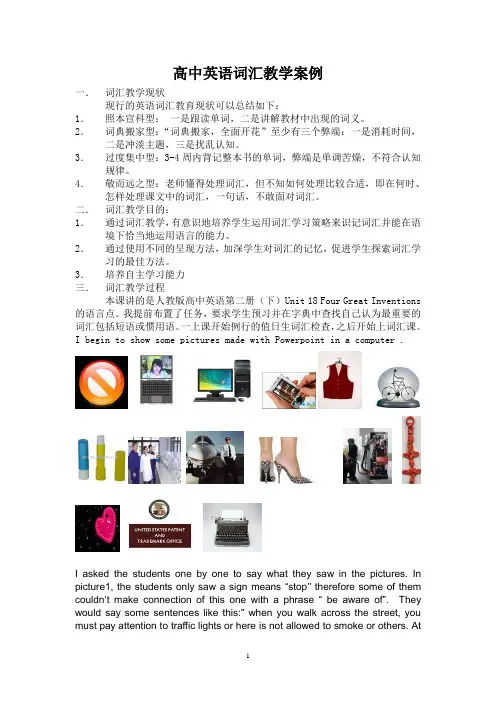
高中英语词汇教学案例一.词汇教学现状现行的英语词汇教育现状可以总结如下:1.照本宣科型:一是跟读单词,二是讲解教材中出现的词义。
2.词典搬家型:“词典搬家,全面开花”至少有三个弊端:一是消耗时间,二是冲淡主题,三是扰乱认知。
3.过度集中型:3-4周内背记整本书的单词,弊端是单调苦燥,不符合认知规律。
4.敬而远之型:老师懂得处理词汇,但不知如何处理比较合适,即在何时、怎样处理课文中的词汇,一句话,不敢面对词汇。
二.词汇教学目的:1.通过词汇教学,有意识地培养学生运用词汇学习策略来识记词汇并能在语境下恰当地运用语言的能力。
2.通过使用不同的呈现方法,加深学生对词汇的记忆,促进学生探索词汇学习的最佳方法。
3.培养自主学习能力三.词汇教学过程本课讲的是人教版高中英语第二册(下)Unit 18 Four Great Inventions 的语言点。
我提前布置了任务,要求学生预习并在字典中查找自己认为最重要的词汇包括短语或惯用语。
一上课开始例行的值日生词汇检查,之后开始上词汇课。
I begin to show some pictures made with Powerpoint in a computer .I asked the students one by one to say what they saw in the pictures. In picture1, the students only saw a sign means “stop‟‟ therefore some of them couldn‟t make connection of this one with a phrase “be aware of”. They would say some sentences like this:” when you walk across the street, you must pay attention to traffic lights or here is not allowed to smoke or others. Atthis time I began to ask the students what the sign said and when we saw this sign , what should be aware of. Following that , all the students said that they would be aware of safety. Then I asked my students to make sentences with the phrase be aware of as much as possible. Picture 2,3,4,5,6,7 are very easy . When they saw them , they would quickly remember what words they were. Once for a while I interestingly asked them what made the size of a computer reduced from desktops to laptops to palmtops and If they pretended to be specialists of a computer whether they allow for their creativity. After that the students discussed for a while ,then one reported the result. Picture8 tends to make the students remind the word “experiment” or ” laboratory” instead of “trial but they knew trial and error could lead to success and the truth of success is trial and error. Picture9 is about a “pilot “and picture10 is “heel”while picture11 ,12 and 13 need hard guess. Because in these pictures they couldn‟t see “ petrol ““ connection” and “ background”, teacher must lead in. For example I asked my students the following questions : What does picture 11 describe? Is it a gas station? What does the driver do ? What do Americans say “汽油”?When you see picture 12, what do you feel ? what association do you make? ( we often connect this China knot with good luck ) and in picture13, can you see the black color? What function is it used as? In this way, the students had a quick overview of some important new words in Unit 18. Secondly, I quickly show these pictures to the students. Then let them repeat these new words. In class I found it interesting for students to learn new words and with this method students‟motivation can be aroused. What‟s more ,it‟s easy for them to remember new words. When I finished this task , I began to check the students‟ preparations.In latter half class, the students play leading roles in class. They voluntarily come to the blackboard to teach the others the key words and phrases that they think are very important in Unit 18 . Although it is impossible for them to find the key points accurately , in practice they know how to learn new vocabulary. What …s more, the students are very active in involving in class.四.课后反思反思1:学生学习的主动积极性是学生学习的动力源泉而学习需要是学生长期坚持的内驱力。
高中英语词性教学设计案例
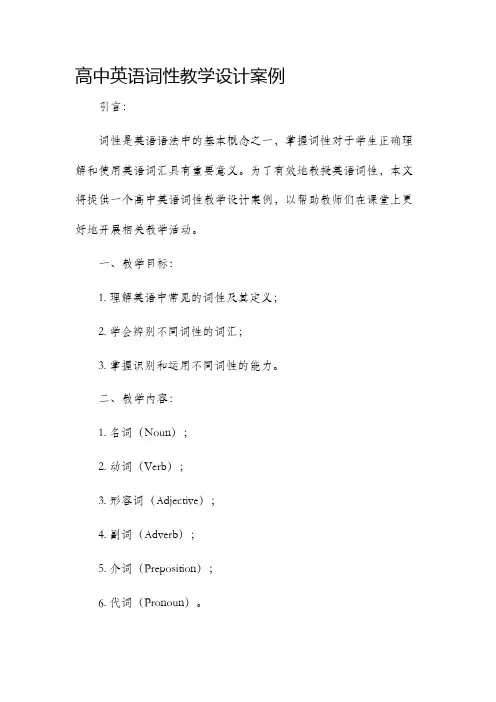
高中英语词性教学设计案例引言:词性是英语语法中的基本概念之一,掌握词性对于学生正确理解和使用英语词汇具有重要意义。
为了有效地教授英语词性,本文将提供一个高中英语词性教学设计案例,以帮助教师们在课堂上更好地开展相关教学活动。
一、教学目标:1. 理解英语中常见的词性及其定义;2. 学会辨别不同词性的词汇;3. 掌握识别和运用不同词性的能力。
二、教学内容:1. 名词(Noun);2. 动词(Verb);3. 形容词(Adjective);4. 副词(Adverb);5. 介词(Preposition);6. 代词(Pronoun)。
三、教学过程:1. 导入(5分钟)介绍词性的概念,并说明其在英语语法中的重要性。
与学生分享一些与词性相关的例子,以引发学生的学习兴趣。
2. 概念讲解(10分钟)分别对不同的词性进行讲解和定义,通过实例让学生对每种词性有更深入的理解。
教师可以用黑板或投影仪展示相应的词汇,并解释其词性及意义。
3. 识别练习(20分钟)给学生分发一份包含不同词性的文章,要求学生在规定的时间内找出文章中的名词、动词、形容词、副词、介词和代词,并在纸上进行标记。
老师可以逐个词性进行讲解,让学生进行核对和订正。
4. 语法规则解释(15分钟)针对不同词性,教师可以解释相关的语法规则,如名词的单复数变化规则、形容词和副词的比较级和最高级形式等。
通过对语法规则的解释,帮助学生更好地理解和应用不同的词性。
5. 句子构建练习(20分钟)让学生运用所学的词性知识,进行句子构建练习。
教师可以给出一些主题,要求学生根据主题构建意义完整的句子,注意使用正确的词性。
通过这种方式,学生可以更加灵活地运用不同的词性,提高他们的语言表达能力。
6. 小组活动(15分钟)组织学生分小组进行小组活动,要求学生用不同词性的单词进行造句比赛。
通过小组竞争的形式,激发学生的学习兴趣,并提高他们在词性运用方面的能力。
7. 总结和问答(10分钟)对本节课的内容进行归纳总结,并与学生进行互动问答。
英语教学案例范文10篇
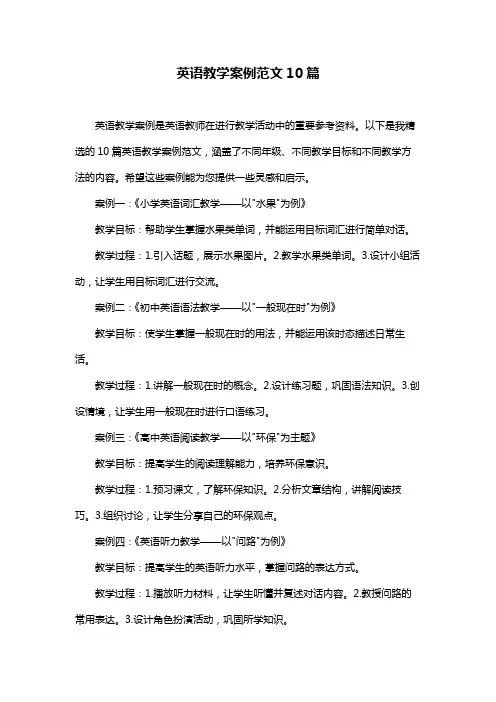
英语教学案例范文10篇英语教学案例是英语教师在进行教学活动中的重要参考资料。
以下是我精选的10篇英语教学案例范文,涵盖了不同年级、不同教学目标和不同教学方法的内容。
希望这些案例能为您提供一些灵感和启示。
案例一:《小学英语词汇教学——以"水果"为例》教学目标:帮助学生掌握水果类单词,并能运用目标词汇进行简单对话。
教学过程:1.引入话题,展示水果图片。
2.教学水果类单词。
3.设计小组活动,让学生用目标词汇进行交流。
案例二:《初中英语语法教学——以"一般现在时"为例》教学目标:使学生掌握一般现在时的用法,并能运用该时态描述日常生活。
教学过程:1.讲解一般现在时的概念。
2.设计练习题,巩固语法知识。
3.创设情境,让学生用一般现在时进行口语练习。
案例三:《高中英语阅读教学——以"环保"为主题》教学目标:提高学生的阅读理解能力,培养环保意识。
教学过程:1.预习课文,了解环保知识。
2.分析文章结构,讲解阅读技巧。
3.组织讨论,让学生分享自己的环保观点。
案例四:《英语听力教学——以"问路"为例》教学目标:提高学生的英语听力水平,掌握问路的表达方式。
教学过程:1.播放听力材料,让学生听懂并复述对话内容。
2.教授问路的常用表达。
3.设计角色扮演活动,巩固所学知识。
教学目标:培养学生的英语写作能力,学会用英语记录生活。
教学过程:1.讲解日记的格式和写作技巧。
2.提供写作素材,指导学生进行创作。
3.互相批改,提高写作质量。
案例六:《英语口语教学——以"旅游"为例》教学目标:提高学生的英语口语水平,学会用英语描述旅游景点。
教学过程:1.展示旅游景点图片,引导学生用英语进行描述。
2.教授相关表达,如:询问景点信息、推荐旅游景点等。
3.组织口语交流,让学生互相分享旅游经历。
案例七:《英语课堂教学游戏设计——以"猜词游戏"为例》教学目标:激发学生学习英语的兴趣,提高课堂参与度。
最新高中英语词汇教学教案案例
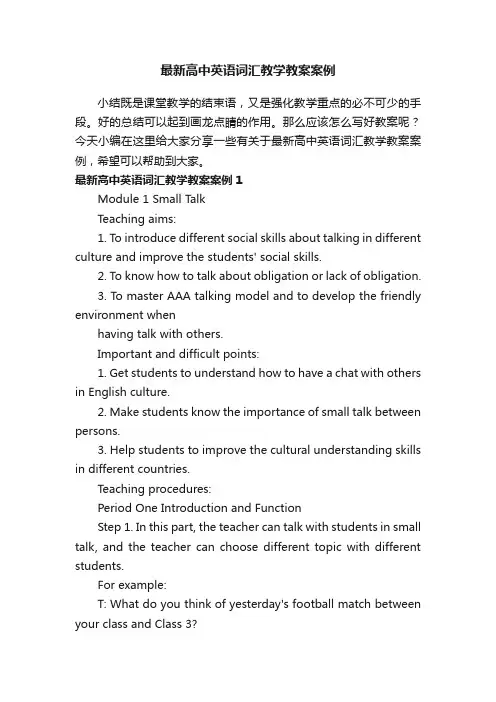
最新高中英语词汇教学教案案例小结既是课堂教学的结束语,又是强化教学重点的必不可少的手段。
好的总结可以起到画龙点睛的作用。
那么应该怎么写好教案呢?今天小编在这里给大家分享一些有关于最新高中英语词汇教学教案案例,希望可以帮助到大家。
最新高中英语词汇教学教案案例1Module 1 Small TalkTeaching aims:1. To introduce different social skills about talking in different culture and improve the students' social skills.2. To know how to talk about obligation or lack of obligation.3. To master AAA talking model and to develop the friendly environment whenhaving talk with others.Important and difficult points:1. Get students to understand how to have a chat with others in English culture.2. Make students know the importance of small talk between persons.3. Help students to improve the cultural understanding skills in different countries.Teaching procedures:Period One Introduction and FunctionStep 1. In this part, the teacher can talk with students in small talk, and the teacher can choose different topic with different students.For example:T: What do you think of yesterday's football match between your class and Class 3?S1: It's great.S2: We won.T: Do you know why you won?S3: We are strong.T: Good. When we were discussing the football match just now, we were discussing serious things or having light conversation?Ss: Light conversation.T: Oh, yes. Just small talk.Step 2. After the teacher tell the students small talk, the students begin to read the dictionary definitions of small talk then ask the students to discuss the four questions inActivity1.Step 3. Divide the students into groups of two ones to discuss the five questions in Activity2. Then the teacher can choose some groups of students to show their small talk to all the students. The Ss can have different opinions, but they must give the reason for their opinions.Step 4. Make a talk between the Ss and the teacher, then introduce the topic about must, have to, don't have to and mustn't.For example:T: You are now in Senior Two, and I think you are all good students, although some of you sometimes behave not very properly. So I'm going to ask you some questions. Do you think students have to be on time at school?Ss: ...T: Oh, yes. You are right. You have to. Then say something that you must do.S1: ...S2: ...T: And anything you mustn't do?S1: ...S2:...Ask the Ss to talk about the following topics:What is obligation?What is lack of obligation?According to the talking method, the teacher can introduce the definitions of obligation and lack of obligation.Step 5. Ask the students to finish Activity1 and then let the Ss to talk about the answers they have made.Ask the Ss to make similar sentences impressing obligation and lack of obligation using the words they just practiced.Step 6. Make a competition among the Ss to make sentences using must, have to, don't have to, mustn't, needn't do and don't need do. And the team which make sentences will win the competition.Period Two Vocabulary and ReadingStep 1. Ask Ss to discuss the sentences in Activity 1 and then check the answers of the Ss'. Then learn the words in this part with the Ss.Step 2. Ask the Ss to read the text quickly and then finish Activity2. Then ask all the Ss to discuss the questions of Activity 4. Then ask the Ss to tell us the usage of the words in Activity1 and Activity 4 and find the sentences in the text: impress, damage, encourage, prepare, avoid, lack, recognize, smile.Step 3. Ask the students to read the text again, then answer the questions in Activity3 and encourage the Ss to have different answers. If the time isn't enough, we can solve the problem in the following ways.(1) Discuss it after class.(2) Discuss the following questions as the important points.I. What do people think about those who talk too much?II. Why is it a good idea to nod and smile when the other person is talking?III. What does the quotation from Benjamin Disraeli tell you about people?Then ask the Ss to prepare for Activity5 and then ask the Ss to tell the meanings of the phrases.Step 4. Important word or phrases1. Which definitions make small talk sound like a positive thing?Sound is a link verb,its meaning in Chinese:听起来。
高中英语教学设计优秀7篇
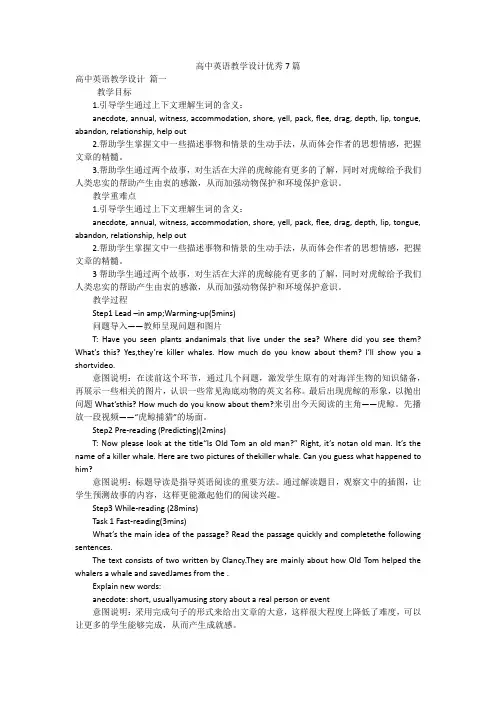
高中英语教学设计优秀7篇高中英语教学设计篇一教学目标1.引导学生通过上下文理解生词的含义:anecdote, annual, witness, accommodation, shore, yell, pack, flee, drag, depth, lip, tongue, abandon, relationship, help out2.帮助学生掌握文中一些描述事物和情景的生动手法,从而体会作者的思想情感,把握文章的精髓。
3.帮助学生通过两个故事,对生活在大洋的虎鲸能有更多的了解,同时对虎鲸给予我们人类忠实的帮助产生由衷的感激,从而加强动物保护和环境保护意识。
教学重难点1.引导学生通过上下文理解生词的含义:anecdote, annual, witness, accommodation, shore, yell, pack, flee, drag, depth, lip, tongue, abandon, relationship, help out2.帮助学生掌握文中一些描述事物和情景的生动手法,从而体会作者的思想情感,把握文章的精髓。
3帮助学生通过两个故事,对生活在大洋的虎鲸能有更多的了解,同时对虎鲸给予我们人类忠实的帮助产生由衷的感激,从而加强动物保护和环境保护意识。
教学过程Step1 Lead –in amp;Warming-up(5mins)问题导入——教师呈现问题和图片T: Have you seen plants andanimals that live under the sea? Where did you see them? What’s this? Yes,they’re killer whales. How much do you know about them? I’ll show you a shortvideo.意图说明:在读前这个环节,通过几个问题,激发学生原有的对海洋生物的知识储备,再展示一些相关的图片,认识一些常见海底动物的英文名称。
牛津高中英语教学案例与分析
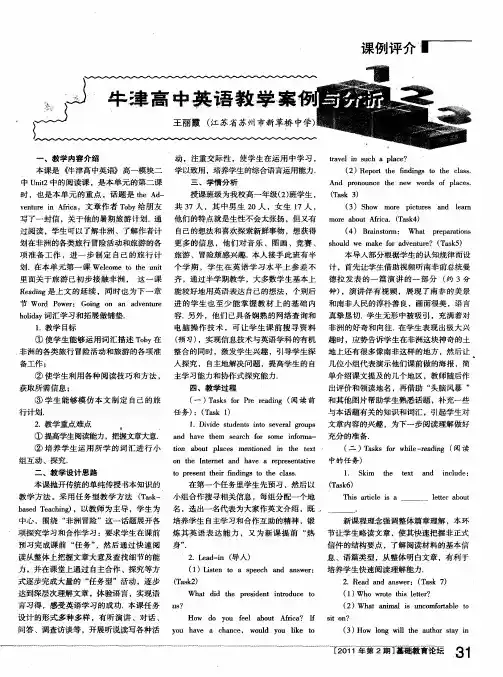
、
项探究学习和合作学习 :要求学生在课前 炼 其英 语表 达能 力 ,又 为新 课 提前 “ 热 节让学生略读文章 ,使其快速把握非正式
力 ,并在课 堂上通过 自主合作 、探究等方
达到深 层次理解 文章 ,体 验语 言 ,实现语 言习得 ,感受英语学 习的成 功.本课任 务
( ) ak .rw i -edn ( 读 二 T ss f h e raig 阅 o l
② 使学生利 用各种阅读技 巧和方法 , 主学 习能力 和协作式探究能力 . 获取所需信息 ; ③ 学 生能 够模 仿本 文制 定 自己 的旅
行计划.
四、教 学过 程
任 务 ) T s ) :( ak 1
备工作 ; 入探究 ,自主地解决 问题 ,提 高学 生的 自 几位小组代表演示他们课前做的海报 ,简 单介绍课文提及的几个地区 ,教师随后作 出评价和领读地名 ,再借助 “ 头脑风暴 ” 与本话 题有关的知识和词汇 ,引起学生对 文 章内容的兴趣 ,为下一 步阅读理解做好 充 分的准备.
中 Ui nt 2中的 阅读课 ,是本单元 的第二课 时 ,也是本单 元 的重点 ,话题是 te A — h d
( )Re o te f dn s o te cas 2 p f h i ig t h ls. l n
An p o o n e h n w r s f p a e . d r n u c t e e wo d o lc s
Ho d y u e l b u A rc ? I st o w o o f e a o t f a i f i n? y u a e c a c o h v a h n e, wo l y u i e o u d o l t k
高中英语教学设计案例5篇
高中英语教学设计案例5篇高中生要作好充分思想准备,以自信、宽容的心态,尽快融入集体,适应新同学、适应新校园环境、适应与初中迥异的纪律制度。
记住:是你主动地适应环境,而不是环境适应你。
因为你走向社会参加工作也得适应社会。
接下来是关于高中英语教学设计案例的文章,希望能帮助到大家!高中英语教学设计案例1Teaching Aims and DemandsWords and PhrasesFour Skills: stomach fever ought ought to examine plenty plenty of diet keep up with make a right choice short of fit gain now and thenThree Skills: energy soft bar fuel chemical balance tasty boil mixtureSpoken English:In the clinic / seeing a doctor:What’s wrong with you?/What’s the matter with you?Lie down and let me examine you.Let me have a look.Where does it hurt?Drink plenty of water and get some rest.I’ve got a pain here. This place hurts.There’s something wrong with back/my kn ee/my arm.I don’t feel well.Grammar:Use of Language:1. Master the function use of language as defined above.2. Help the students to finish the tasks of listening, reading, writing, speaking presented in the book and the exercise bookthrough using what the students have learned.Learn the text about healthy eating. Get the students know about the basic knowledge of how to eat healthily.Important points:1. Talk about different kinds of food that one favorites.2. learn the basic knowledge of healthy eating.3. learn how to say in the clinic.4. Grasp the language points and grammar in the text.Difficult points: The use of modal verbs --- had better, should and ought to.Teaching aids: computer or slider-projectorWay of Teaching: Communication way of teaching, discussion and group work.Lesson 1Step 1 Warming-UpFirst show the students some pictures of dishes and so to introduce the topic of this unit.And then show the pictures on their text books and let them to decide what is junk food and what is not.Here the students may have a short ask and answer in pairs to themselves more engaged in the topic.Step 2 ListeningLet the students listen to the tape and be prepared to answer the questions below.Step 3 SpeakingShow the students the three situations as on P2. Then ask the students to prepared a dialogue according to the examples in pairs. Ask several pairs of students to present their dialogue After that list the useful expressions in their dialogue.Step 4 HomeworkPrepare for the next class.Collect some menus if possible for the next class.Lesson 2Step 1 IntroductionUsing the questions on P3 to introduce the new text.Step 2 Fast-reading1.What does the “fuel ” mean in the first paragraph?(It means different kinds of materials, such as protein, Calcium that we need to keep healthy.)2.What do we have to consider when we choose to buy or eat?(What kinds of nutrients that the food contain.)3.What made our eating habit changing?(Many things: what people believe, advice from companies and stores.)4. How can we feel and look fine?(We ought to learn about our body and the fuel it needs to keep fit.)Explain the language points if necessary.Step 3 Carefully-readingHow many parts can be divided into?(Three parts.)What’s the main idea of each part?(1.our eating habits are changing. 2.why the eating habits are changing 3.the best way to develop healthy eating habits.) Step 4 TalkingAsk the students to take out their menus and read them carefully. Then prepare a dialogue that may happen between a customer and a waiter/waitress.Step 5 HomeworkFinish the exercise --- Vocabulary on P5. and P72-73Lesson 3Step 1 RevisionCheck the homework.Step 2 GrammarFirst present the students the modal sentences with Modal Verbs and ask the students to make some sentences with them.Step 3 Consolidation(1) Finish the exercise on P5 and on P74(2)Take out a piece of paper with the column “Ask ###” in order to make the students understand when you are giving advice it is better to use some sentences with had better (not), and ought(not) to, should(not). Then read a passage as an example and afterwards list the points you have to pay attention to when you give advice.1.give advice that will really help the person.2. be polite and sincereat last get the students to finish the following practice.Step 4 HomeworkFinish the exercise 3 on P74 in the students’ workbook.Lesson 4Step 1 RevisionLet some students read their reply to the letters on P74.Step 2 ReadingRead the text on P6 and then get the students to find the main idea of it (Snacks is also important . we need to learn something about snacks and the way to prepare it.)Step 3 WritingAsk the students to work in pairs to write the recipe for their favourite dish.We may first give the tips on P7 as a guide.Step 4 DiscussionFirst ask the students to read the passage on P75 and then give the following questions as the topic for the students to talk: What is a couch potato?What does one have to pay special attention to in order to keep healthy? (food and exercise etc.)Step 5 HomeworkDo a general survey in order to learn about the differences between people’s eating habits and try to find which is healthier.高中英语教学设计案例2Teaching aims and demands:a. Achieve language skills and related knowledge about the topic of friends and friendship;b. Learn to express likes and dislikes and make apologies:c. Vocabulary in this unit:the words and expressions listed on the teacher’s bookd. Grammar:Direct and indirect speechLesson 1Step 1 Presentation and discussion (warm-up)Put some new words on the blackboard and tell them something about a friend.Kind honest brave loyal happy wise strongbeautiful handsome rich smart funnyThen ask some questions around the class and discuss with them.What should a good friend be like?What qualities should a good friend have?Should they be funny, smart and strong?Step 2 ReadingAsk the students to read the dialogue in the part SPEAKING. Ask some questions:1.What doesn’t John like?2.What does Joe think of music and skiing?And then fill in the form on page 3.Then ask the students to express their ideas freely. Encourage the students to say more about friends.Step 3ListeningAsk the students to listen to the tape and fill in the blanks in the listening part.Step 4 Talking/PracticeAsk the students to page 85. Make a similar dialogue as in exercise 2.Some useful expressions :Why did you…? Why didn’t you…? You said that you would…Please forgive me. You promised to … I’m very sorry… It won’t happen again. I forgot.Step 5 HomeworkFinish Exercise 3 in the workbook.Lesson2Step1 RevisionAsk several students to present a speech about friends as a revision.Step 2 Pre-readingPresent the students a picture to illustrate the situation on a lonely island. Ask them to list three items in the box and ask them to give the reasons using the sentences listed on page3.Step 3 ReadingBefore asking the students to read the text, first give the students a brief introduction about Tom Hanks, his films and the film Cast Away.Then students read the text, and answer the following questions.1.How does Chuck Noland come to a deserted island?2. In order to survive on the island alone, what does he need to learn?3. What does he understand at last?4. For us, what lesson we can learn from Chuck?At the same time explain the language points if necessary.Step 4 Post-readingDiscuss the following questions in the Part POST-READING.Step 5 HomeworkPrepare a talk about Tom Hanks or something about one of his film.Lesson3Step 1 RevisionGet the students to give a talk about Tom Hanks or something about one of his films.Step 2 Language StudyAsk the students fill in the blanks with proper words.Step 3 GrammarIllustrate to the students the use of Direct and Indirect Speech.Then ask the students to do the exercise in the Part Grammar on P5.Step 4 PracticeAsk the students to act the exercise2 in the part Grammar out.Step 5 HomeworkAsk the students to finish the exercise2 in their workbook.Lesson4Step 1 RevisionCheck the homework.Step 2 PresentationPresent simples of e-mail to get the students a general idea of e-mail.Step 3 ExplanationTell the students some tips of writing an e-mail by learn the above e-mail simple.Step 4 WritingAsk the students to write an e-mail message.Step 5 HomeworkAsk the students to try to write an e-mail to their e-pal.高中英语教学设计案例3Ⅰ. Teaching Basis (教学依据) :《普通高中英语新课程标准》Ⅱ. The Type of the Text (课型) :Revision (复习课)Ⅲ. Teaching Methods(教学方法): Question-based method(提问式),Group discussionmethod(小组讨论法),Cooperative learning(合作探究),Practicing(练习).Ⅳ. Teaching Aids (教学手段) :Multimedia computer(多媒体电脑),Learningpaper(导学案),Blackboard(黑板).Ⅴ. Teaching Aims(教学目标) :①Knowledge aims(知识目标): words: achievement, specialist, organization, hard-working, confident….. phrases: put to death, mean doing, either…or…, the bond between……, structure: only+…., It is/was+….+that…. grammar: Subject-verb agreement.②Ability aims(能力目标): Develop the students’ ability to use the importantlanguage points, enable students to describe people using the adjectives.③Emotional aims(情感目标): Encourage the students to think about what makes aperson great.Ⅵ. Teaching focuses(教学重点):Get the students to review and consolidate what theyhave learned in this unit.Ⅶ. Teaching difficulties(教学难点):Get the students to turn what they have learned intotheir ability.Ⅷ.Teaching procedure(教学过程): Step 1 复习学案情况反馈(1分钟)Step 2 lead-in :通过图片展示的方式,过渡到知识竞答类节目《一站到底》,本节课也将模仿这种模式授课。
基于话题的高三英语一轮词汇复习—— heroes in harm's way 教学案例
基于话题的高三英语一轮词汇复习—— heroes in harm's way教学案例引言:王蔷教授也曾强调“语言源于生活,语言学习不应该紧紧围绕词汇和语法知识来学习,语言的理解和表达都与生活紧密相连……而学习解决问题的过程必须通过参与真实生活情境的活动来加以解决”(王蔷,2016)。
因此教师在选择材料时,“可选择与单元话题相关且包含高考核心词汇较多的新闻素材才,实现课堂与生活的有效衔接”(黄娟,2020)i.理论依据英语学科所含的三大主题语境又分别涵盖十大主题群以及所对应的32个语境范围。
其中的人与社会以其内容丰富性,有“社会服务与人际沟通”“文学、体育与艺术”“历史、社会与文化”“科学与技术”四个主题群和下设的16项子主题。
本课以人与社会主题语境和“历史、社会与文化”主题群为切入点,选择了16项子主题里面对社会有突出贡献的人物和社会热点问题两项话题作为理论依据,以武汉爆发疫情之时,涌现了无数传递正能量的逆行者为具体情境筛选和原创了英文阅读材料,设计了本节一轮复习词汇课heroes in harm’s way (逆行者)。
ii.教学内容分析本课的八个目标词块分别:①work selflessly in ②fight against③be grateful to ④devote oneself to⑤a specialist in⑥an outbreak of⑦die of⑧get infected其中devote oneself to,work selflessly in,fight against和be grateful to 选自必修一五单元nelson mandela- a modern hero,所选短语涉及曼德拉和白求恩;其中a specialist in和 devote oneself to 选自必修四一单元great women and their achievements,所选短语涉及到林巧稚;其中an outbreak of和die of 选自必修五的一单元great scientist,所选短语分别涉及到阅读文章霍乱这种传染病;最后一个短语get infected,选自必修五第五单元,描述皮肤烧伤急救的措施。
高中英语优秀教学设计3篇(人教版高中英语教学设计优秀案例)
高中英语优秀教学设计3篇(人教版高中英语教学设计优秀案例)下面是收集的高中英语优秀教学设计3篇(人教版高中英语教学设计优秀案例),以供借鉴。
高中英语优秀教学设计1一、教材分析:本课是结合人教版高中英语教材选修5中有关过去分词的语法内容,进行过去分词的学习,教学中将语法知识的传授和语言基本技能的学习结合到一起,注重复习语法与语言的运用。
采用任务型教学法和小组合作探究学习法,从而扩大课堂的语言输入量及学生的语言输出量。
二、学情分析:在高一英语学习基础上,学生已经掌握基本的语言结构和一定程度的听说读写能力。
在复习的过程中,结合学生原有的知识掌握水平,巩固基础强化正确使用语法知识,提高学生运用语言的深度和难度.但大部分学生的基础知识仍然较为薄弱,运用英语进行交际活动的能力较差,主动学习的动力不够,然而他们学习比较认真,渴求知欲旺盛,思维比较活跃。
部分学生的基础较好,能主动配合老师。
只有设置使他们感兴趣的活动,因材施教,才能让他们投入到课堂活动中来。
三、教学目标:1.知识目标:引导学生掌握过去分词在真实的生活语境中的使用。
培养学生通读,分析,理解,综合的能力,教会学生体察语境,结合上下文,符和逻辑推理和合理的想象,结合语法和题干中的语境解决问题。
在运用语言过程中培养学生的观察力、分析力、想象力和自学能力,提高思维能力和运用英语的综合能力。
2.能力目标:利用多媒体手段营造积极和谐教学氛围,使学生进入情景之中,充分调动学生的思维活动和情感体验,规范学生运用英语知识准确表达的能力,同时,发展学生综合语言运用的能力,分析问题和解决问题的能力,培养学生自主学习。
3.德育目标:用含过去分词的句子结构表达思想感情。
四、教学重点:1.过去分词的用法.2. 过去分词的运用五、教学难点:1.结合语法知识,以课堂教学为依托,全面训练学生的听、说、读、写能力,加强和提高运用英语的综合能力。
2. 过去分词在真实的生活语境中的使用。
高中英语教学全英案例
中学英语教学案例一.教材分析本单元以A healthy life为话题,通过谈论人们最关切的健康问题,使学生相识到吸烟、喝酒、吸毒、不良饮食等对健康的危害,了解吸烟的危害及怎样戒烟;通过阅读一篇有关艾滋病的宣扬文章了解一些艾滋病的常识及如何预防艾滋病;并学会如何就健康问题给别人供应一些建议;功能句式要求学生学会如何表达聚会中的礼仪和禁忌。
通过单元学习,要求学生意识到健康的重要性,养成良好的生活习惯,并学会帮助别人解决一些健康问题。
1.1 Warming Up列举了一些年轻人所关切的健康问题,由此引出单元话题。
要求学生列举出更多类似的健康问题,然后在小组和班级范围内进行比较,说出哪个问题是最重要的,并列举出5个有关这个问题人们应当了解的学问。
1.2 Pre-reading要求学生探讨5个与吸烟有关的问题,为后面的Reading做铺垫。
1.3 Reading是一封爷爷写给James的建议信,信中谈到了吸烟为什么会上瘾、吸烟对健康的危害并附上了一篇如何戒烟的文章来帮助James戒烟。
1.4 Comprehending要求学生探讨几个与Reading内容有关的问题,并依据Reading的内容完成表格。
另外还要求学生用自己的语言简要概述一下advice on how to stop smoking。
1.5 Learning about Language包括两部分:Discovering useful words and expressions是两个关于Reading中的一些词汇的练习;Discovering useful structures 是关于it structure的用法介绍和练习。
1.6 Using Language是一篇关于HIV / AIDS的宣扬材料,介绍了一些有关艾滋病病毒和艾滋病的基本学问以及在生活中如何进行预防。
要求学生能推断一些相关陈述的正误。
1.7 Listening是Tina和Sara之间的一段对话,要求学生能听出一些关键词并完成句子。
- 1、下载文档前请自行甄别文档内容的完整性,平台不提供额外的编辑、内容补充、找答案等附加服务。
- 2、"仅部分预览"的文档,不可在线预览部分如存在完整性等问题,可反馈申请退款(可完整预览的文档不适用该条件!)。
- 3、如文档侵犯您的权益,请联系客服反馈,我们会尽快为您处理(人工客服工作时间:9:00-18:30)。
第 3-5 分钟
调查词汇 记忆情况
询问学生最喜欢和最不愿意记 写出自己常用的记忆 忆的单词是什么, 以及通常在课 方法,告知记忆困难。 内和课后记忆单词的方法。 让学 生写出记忆词汇过程中遇到的 困难或者记忆词汇的良好方法, 供大家分享。
教学片段二
时间 第 1 分钟 第 1-2 分钟 教学步骤 启动教学 任务回顾 教师活动 学生活动 教学目的 问候学生, 启动教学。 调动学生的 已有知识。
教授学习 策略
第 5 分钟
总结
学生利用词 汇图更好地 促进英语学 习。
教学片段三
时间 第 1 分钟 第 1-2 分钟 教学步骤 启动教学 引入任务 教师活动 学生活动 教学目的 问候学生, 启动教学。 引导学生从 课本出发, 利用课文辅 助写作和学 习。 让学生体会 学习与语言 运用主体的 良好感觉。 通过课文学 习 了 解 词 汇。 就新语词进 行交际。
第 3-5 分钟
教授词汇 学习策略
教师结合实例等方法, 边问边逐 条生动地讲解 8 条词汇学习策 略, 可适当用中文辅助讲解帮助 学生理解。
在教师的指引下, 认真 思考这些策略的含义 和用法,分析自己学 习,哪些策略用到过, 哪些策略没有用到过。
第 3-4 分钟
学习新语 词 运用新语 词
认真听老师的讲解, 并 阅读文章,理解其运 用。 就自己的理解将文中 的表达运用重点语词
让学生明了 语词用法。 在语用中深 入理解新语
第 5 分钟
说话。
词用法。
教学片段五
时间 第 1 分钟 第 1-2 分钟 教学步骤 启动教学 引入活动 教师活动 学生活动 教学目的 问候学生, 启动教学。 考核学生对 语词的理解 是否准确到 位。 在课文学习 与理解中学 习语词。
第 2 分钟
选择可用 语词
根据自己的理解和喜 好选择几个在写作中 能够用得上的语词, 并 就自己选择的语词造 句运用。 熟悉课文, 听取特征描 述词汇, 猜测具体的老 师。
第 3-4 分钟
熟悉运用 新语词 运用新语 词
第 5 分钟
请学生谈谈自己喜欢哪个老师, 就自己的喜好, 选择喜 并说明理由。 欢的老师, 并就其性格 特征、 教学风格等说明 理由。
向学生问好:Hello!Everyone! 向教师问好:Hello! 教师引导学生谈到上节课有一 个汶川地震的短文写作任务, 现 在做一些有益于此次写作的准 备活动。 引导学生进行头脑风暴,说出 Earthquake 的所有词汇, 教师将 这些词汇分类在黑板上画出词 汇网络图。 引导学生思考: What help can you get from this word map for your writing? 教师总结利用词汇图能够更好 地理解学习词汇, 也能帮助我们 写作。 回顾任务
高中英语词汇教学案例
教学片段一
时间 第 1 分钟 第 1-2 分钟 教学步骤 启动教学 调查词汇 量 教师活动 学生活动 教学目的 问候学生, 启动教学。 调查同学们 的英语学习 情况,了解 学生的学习 困难,同时 让学生成为 评价的主体 和积极参与 者。 让学生明了 自己的英语 词汇学习策 略。
向学生问好:Hello!Everyone! 向教师问好:Hello! 教师给出问卷,统计班级人数, 学生自我评价词汇量 询 问 学 生 词 汇 量 是 1500 ? 掌握情况, 举手示意老 1200?1000?并做统计。 师。
教学片段四
时间 第 1 分钟 第 1-2 分钟 教学步骤 启动教学 呈现任务 和新材料 教师活动 学生活动 教学目的 问候学生, 启动教学。 自主选择学 习词汇。
向学生问好:Hello!Everyone! 向教师问好:Hello! 任务呈现: 请学生写几句话描述 暑期中在家一个人的活动。 阅读 一篇关于父母和孩子暑期在家 发生的事情之间的谈话, 找出重 点词汇。 教师就这些重点词汇(in charge、be supposed 等)结合对 话内容进行讲解。 请同学用这些词汇说出文中运 用的意思,并适时纠错。 从文中找出自己不熟 悉或觉得用法比较好 的语词或者生词。
向学生问好:Hello!Everyone! 向教师问好:Hello! 引导学生回顾上堂课“My new teachers” (外研高一 Module2) 并提示写自己教师的任务写作。 问学生能否从已学文章中找到 有利于此次写作的有用词汇, 这 些词汇是什么。 请学生从课文中找出能用于描 述他人的语词和表达, 并请同学 们在黑板上将这些有用语词写 出来。 请学生就自己写出的词汇 适当进行组句说话。 教师就文中三个老师的特征进 行描述, 请学生猜出描述的是哪 个老师。 回顾任务写作, 思考如 何从文章中找出适当 的词汇帮助完成写作 任务。
第 2-3 分钟
词汇图
打开思路, 把能想到的 有关地震的语词都说 出来。 根据自己的写作所需 进行选择和回答, 尽量 找出哪些是能辅助写 作的。 认真思考老师的话, 做 必要的笔记。
通过课文学 习 了 解 词 汇。 词汇图学习 策 略 的 培 养。 适当的总结 能帮助学生 建构词汇图 知识,利于
第 4-5 分钟
教学片段六
时间 第 1 分钟 第 1-2 分钟 教学步骤 启动教学 呈现词汇 学习策略 教师活动 学生活动 教学目的 问候学生, 启动教学。 帮助学生培 养词汇学习 策略意识, 利用有效策 略提升学习 效率。 在教师讲解 中理解策略 的含义与运 用。
向学生问好:Hello!Everyone! 向教师问好:Hello! 教师举例说有同学和他反应过 记忆词汇有困难,教师找到 8 条词汇学习策略帮助同学记忆 词汇,并用 PPT 呈现。 认真听老师的引导, 注 意观看 PPT 呈现的策 略。
向学生问好:Hello!Everyone! 向教师问好:Hello! 引入课文, 核对学生对于课文中 词汇的理解,中英回答皆可。 根据自己的水平和能 力选择用英语或中文 解释语词。 在教师的指引下, 回答 问题, 找到文中相关的 关键词和重要语词。 理 解其语义和用法。
第 3-5 分钟
语词教学
提问 5、6 个问题,引导学生说 出重点语词。 时间:recently 地点:in the middle of Australia 风景:The scenery was colourful 事情:study Chinese 重点讲 abandoned、trained、be called 等-ed 形式的语词以及 Ghan is short for Alghanistan 等 表达。
